It is known that star formation occurs in regions where dense molecular clouds undergo gravitational collapse. While observations of cold dusty disks and envelopes require long wavelength detectors to penetrate through obscuring material—from mid-infrared to radio—it is preferred to observe stars in the range between ultraviolet and near-infrared range (Hartmann 2003).
Note: Difficulties Involved in Observing Star and Planet Formation
